Sustainable Development Goal 16
Promote just, peaceful and inclusive societies
Sustainable Development Goal 16 is to “promote just, peaceful and inclusive societies”, according to the United Nations.
The visualizations and data below present the latest data on our progress there.
The UN has defined 12 targets and 23 indicators for SDG 16. Targets specify the goals and indicators represent the metrics by which the world aims to track whether these targets are achieved. Below we quote the original text of all targets and show the data on the agreed and some related indicators.
List of targets and indicators
Target 16.1Reduce violence everywhere
SDG Indicator 16.1.1Intentional homicides
Definition of the SDG indicator: Indicator 16.1.1 is the “number of victims of intentional homicide per 100,000 population, by sex and age” in the UN SDG framework.
Intentional homicides are unlawful deaths inflicted upon a person with the intent to cause death or serious injury.
Data for this indicator is shown in the interactive visualization.
Target: “Significantly reduce all forms of violence and related death rates” across all countries by 2030.
More research: Further data and research can be found at the Our World in Data topic page on Homicides.
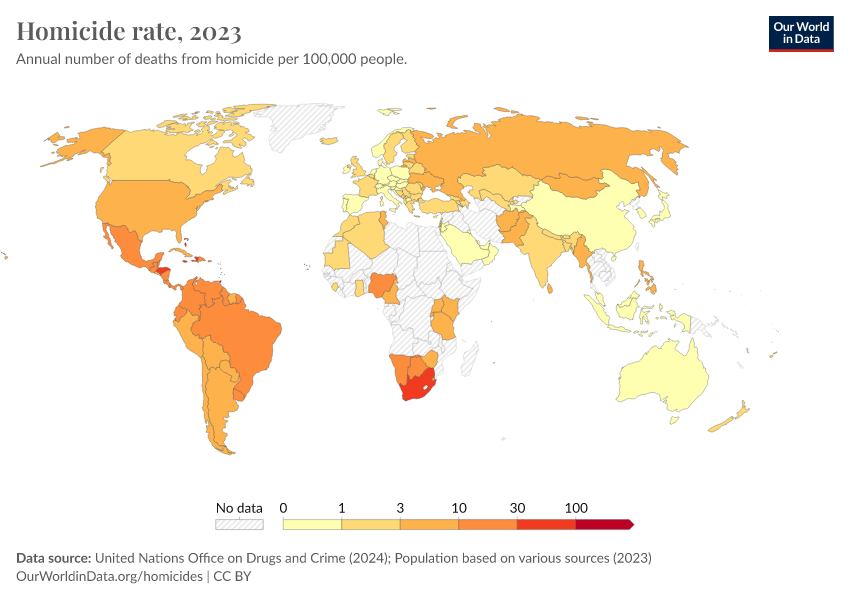
SDG Indicator 16.1.2Conflict-related deaths
Definition of the SDG indicator: Indicator 16.1.2 is “conflict-related deaths per 100,000 population, by sex, age and cause” in the UN SDG framework.
Data for this indicator is shown in the interactive visualization, using data from the Uppsala Conflict Data Program. It includes both deaths from conflicts within countries and between them.
Target: “Significantly reduce all forms of violence and related death rates” across all countries by 2030.
More research: Further data and research can be found at the Our World in Data topic pages on War and Peace and Terrorism.

SDG Indicator 16.1.3Prevalence of all forms of violence
Definition: Indicator 16.1.3 is the “proportion of population subjected to (a) physical violence, (b) psychological violence and (c) sexual violence in the previous 12 months”, in the UN SDG framework.
Data for this indicator is shown in two interactive visualizations for physical and sexual violence by gender. Data on psychological violence is not currently available.
Target: “Significantly reduce all forms of violence and related death rates” across all countries by 2030.
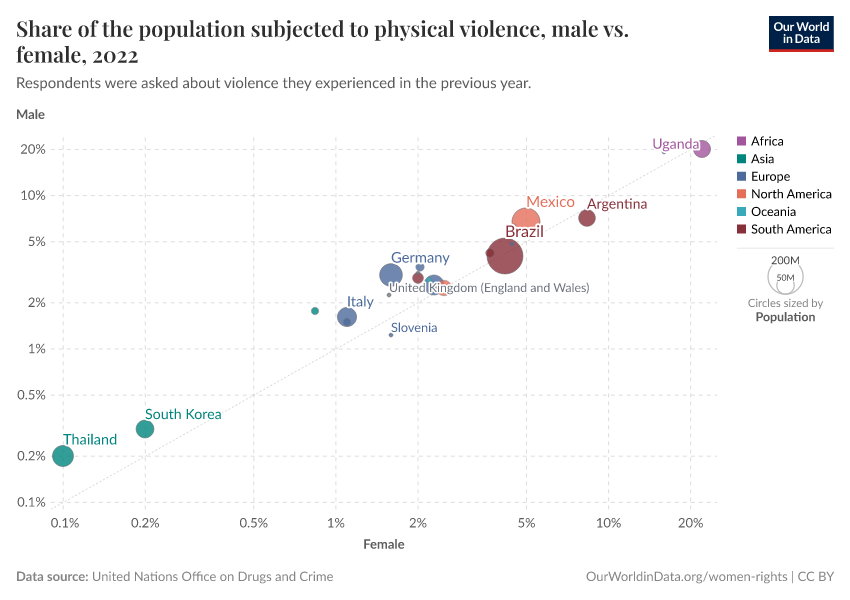
SDG Indicator 16.1.4Public safety
Definition of the SDG indicator: Indicator 16.1.4 is the “proportion of population that feel safe walking alone around the area they live after dark” in the UN SDG framework.
Data for this indicator is shown in the interactive visualization.
Target: “Significantly reduce all forms of violence and related death rates” across all countries by 2030.

Target 16.2Protect children from abuse, exploitation, trafficking and violence
SDG Indicator 16.2.1Violence against children
Definition of the SDG indicator: Indicator 16.2.1 is the “proportion of children aged 1–17 years who experienced any physical punishment and/or psychological aggression by caregivers in the past month” in the UN SDG framework.
This indicator is measured as the percentage of children aged 14 years and younger who experienced physical punishment or psychological aggression from a caregiver in the previous month. Data on violence to adolescents older than 14 years, or violence beyond the home is not available.
Data for this indicator is shown in the interactive visualization.
Target: “End abuse, exploitation, trafficking and all forms of violence against and torture of children” across all countries by 2030.
More research: Further data and research can be found at the Our World in Data topic page on Violence Against & Rights for Children.
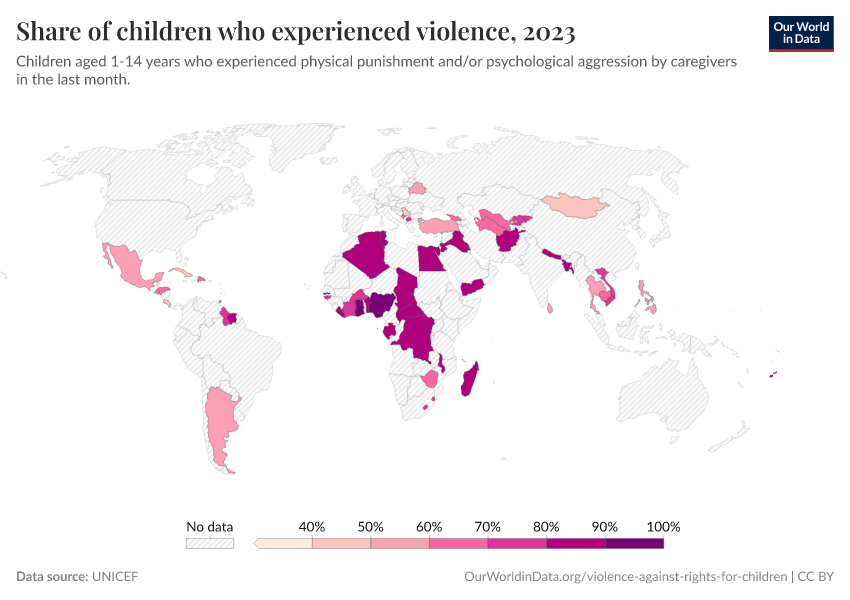
SDG Indicator 16.2.2Human trafficking
Definition: Indicator 16.2.2 is the “number of victims of human trafficking per 100,000 population, by sex, age and form of exploitation” in the UN SDG framework.
Data for this indicator is shown for the total number of human trafficking victims, and by gender for those aged 18 years and younger, and those over 18 years.
Target: “End abuse, exploitation, trafficking and all forms of violence against and torture of children” across all countries by 2030.
More research: Further data and research can be found at the Our World in Data topic page on Human Rights and Violence Against & Rights for Children.

SDG Indicator 16.2.3Sexual violence against young men and women
Definition of the SDG indicator: Indicator 16.2.3 is the “proportion of young women and men aged 18–29 years who experienced sexual violence by age 18” in the UN SDG framework.
Data for this indicator is shown for any form of sexual violence by gender. We also show data for the more narrowly defined forced sex.
Target: “End abuse, exploitation, trafficking and all forms of violence against and torture of children” across all countries by 2030.
More research: Further data and research can be found at the Our World in Data topic page on Violence Against & Rights for Children.
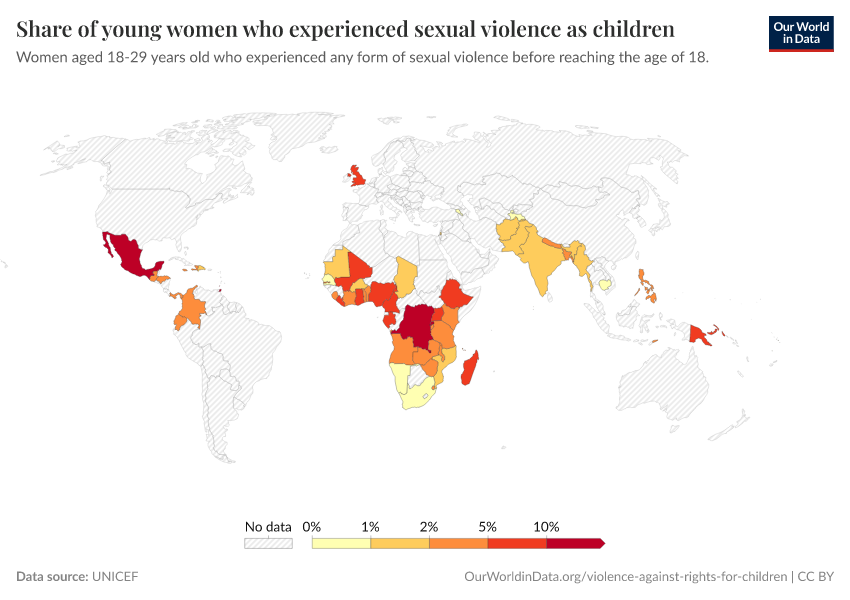
Target 16.3Promote the rule of law and ensure equal access to justice
SDG Indicator 16.3.1Victim reports of crime
Definition of the SDG indicator: Indicator 16.3.1 is the “proportion of victims of violence in the previous 12 months who reported their victimization to competent authorities or other officially recognized conflict resolution mechanisms” in the UN SDG framework.
Data for this indicator is shown in the interactive visualization by type of crime.
Target: “Promote the rule of law at the national and international levels and ensure equal access to justice for all” across all countries by 2030.
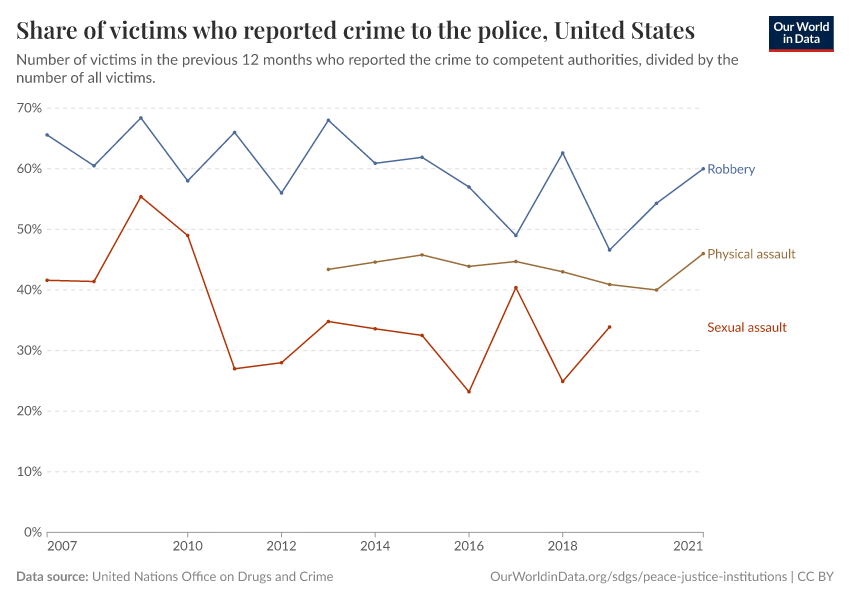
SDG Indicator 16.3.2Unsentenced detainees
Definition of the SDG indicator: Indicator 16.3.2 is “unsentenced detainees as a proportion of overall prison population” in the UN SDG framework.
Data for this indicator is shown in the interactive visualization.
Target: “Promote the rule of law at the national and international levels and ensure equal access to justice for all” across all countries by 2030.

SDG Indicator 16.3.3Dispute resolution
Definition of the SDG indicator: Indicator 16.3.3 is the “proportion of the population who have experienced a dispute in the past two years and who accessed a formal or informal dispute resolution mechanism, by type of mechanism” in the UN SDG framework.
Data for this indicator is so far available for few countries, shown in the interactive visualization.
Target: “Promote the rule of law at the national and international levels and ensure equal access to justice for all” across all countries by 2030.
Additional charts

Target 16.4Combat organized crime and illicit financial and arms flows
SDG Indicator 16.4.1Illicit financial flows
Definition of the SDG indicator: Indicator 16.4.1 is the “total value of inward and outward illicit financial flows (in current United States dollars)” in the UN SDG framework.
There is currently limited data availability for this indicator. For a small number of countries sata regarding illicit financial flows from drug trafficking is available and is shown here.
Target: “Significantly reduce illicit financial and arms flows, strengthen the recovery and return of stolen assets and combat all forms of organized crime” across all countries by 2030.

SDG Indicator 16.4.2Seized or surrendered arms
Definition of the SDG indicator: Indicator 16.4.2 is the “proportion of seized, found or surrendered arms whose illicit origin or context has been traced or established by a competent authority in line with international instruments” in the UN SDG framework.
Data on this indicator is shown in the interactive visualization.
Target: “Significantly reduce illicit financial and arms flows, strengthen the recovery and return of stolen assets and combat all forms of organized crime” across all countries by 2030.

Target 16.5Substantially reduce corruption and bribery
SDG Indicator 16.5.1Bribery prevalence
Definition of the SDG indicator: Indicator 16.5.1 is the “proportion of persons who had at least one contact with a public official and who paid a bribe to a public official, or were asked for a bribe by those public officials, during the previous 12 months” in the UN SDG framework.
Data on this indicator is shown in the interactive visualization.
Target: “Substantially reduce corruption and bribery in all their forms” across all countries by 2030.
More research: Further data and research can be found at the Our World in Data topic page on Corruption.

SDG Indicator 16.5.2Bribery in business
Definition of the SDG indicator: Indicator 16.5.2 is the “proportion of businesses that had at least one contact with a public official and that paid a bribe to a public official, or were asked for a bribe by those public officials during the previous 12 months” in the UN SDG framework.
The indicator is measured differently, as the share of firms experiencing at least one bribe payment request across 6 public transactions dealing with utilities access, permits, licences, and taxes.
Data for this indicator is shown in the interactive visualization.
Target: “Substantially reduce corruption and bribery in all their forms” across all countries by 2030.
More research: Further data and research can be found at the Our World in Data topic page on Corruption.

Target 16.6Develop effective, accountable and transparent institutions
SDG Indicator 16.6.1Governmental expenditures within budgets
Definition of the SDG indicator: Indicator 16.6.1 is “primary government expenditures as a proportion of original approved budget, by sector (or by budget codes or similar)” in the UN SDG framework.
This indicator is measured as the ratio between aggregate budget expenditure and the amount originally approved, expressed in percentage terms.
Data on this indicator is shown in the interactive visualization.
Target: “Develop effective, accountable and transparent institutions at all levels” by 2030.
More research: Further data and research can be found at the Our World in Data topic page on Government spending.

SDG Indicator 16.6.2Satisfaction with public services
Definition of the SDG indicator: Indicator 16.6.2 is the “proportion of population satisfied with their last experience of public services” in the UN SDG framework.
Data for this indicator is so far available for few countries, shown in the interactive visualization.
Target: “Develop effective, accountable and transparent institutions at all levels” by 2030.
More research: Further data and research can be found at the Our World in Data topic page on Trust.

Target 16.7Ensure responsive, inclusive and representative decision-making
SDG Indicator 16.7.1Representation in public institutions
Definition of the SDG indicator: Indicator 16.7.1 is the “proportions of positions in national and local institutions, including (a) the legislatures; (b) the public service; and (c) the judiciary, compared to national distributions, by sex, age, persons with disabilities and population groups” in the UN SDG framework.
Data for this indicator is shown in the interactive visualizations for women’s representation in the legislature and the judiciary.
Target: “Ensure responsive, inclusive, participatory and representative decision-making at all levels” by 2030.
More research: Further data and research can be found at the Our World in Data topic page on Women’s Rights.
Additional charts
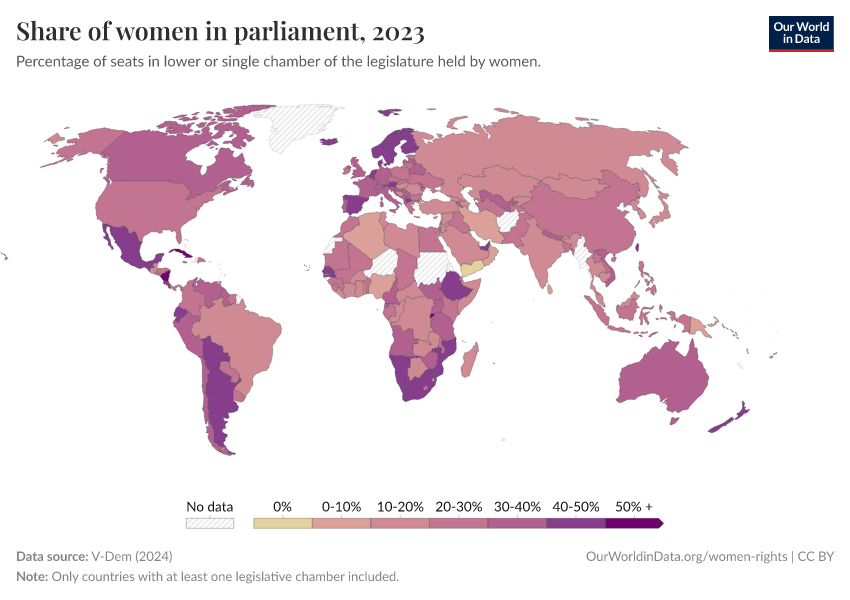
SDG Indicator 16.7.2Inclusive decision-making
Definition of the SDG indicator: Indicator 16.7.2 is the “proportion of population who believe decision-making is inclusive and responsive, by sex, age, disability and population group” in the UN SDG framework.
Data for this indicator is so far available for few countries, shown in the interactive visualization.
Target: “Ensure responsive, inclusive, participatory and representative decision-making at all levels” by 2030.

Target 16.8Strengthen the participation in global governance
SDG Indicator 16.8.1Developing country participation in international organizations
Definition of the SDG indicator: Indicator 16.8.1 is the “proportion of members and voting rights of developing countries in international organizations” in the UN SDG framework.
This indicator shows international organizations each country or region is a member of, and the proportion of voting rights each country is allocated in each organization.
Data for this indicator is shown in the interactive visualizations.
Target: “Broaden and strengthen the participation of developing countries in the institutions of global governance” by 2030.

Target 16.9Provide universal legal identity
SDG Indicator 16.9.1Birth registration
Definition of the SDG indicastor: Indicator 16.9.1 is the “proportion of children under 5 years of age whose births have been registered with a civil authority, by age” in the UN SDG framework.
Data for this indicator is shown in the interactive visualization.
Target: “Provide legal identity for all, including birth registration” by 2030.
This requires universal birth registration in all countries by 2030.
More research: Further data and research can be found at the Our World in Data topic page on World Population Growth.
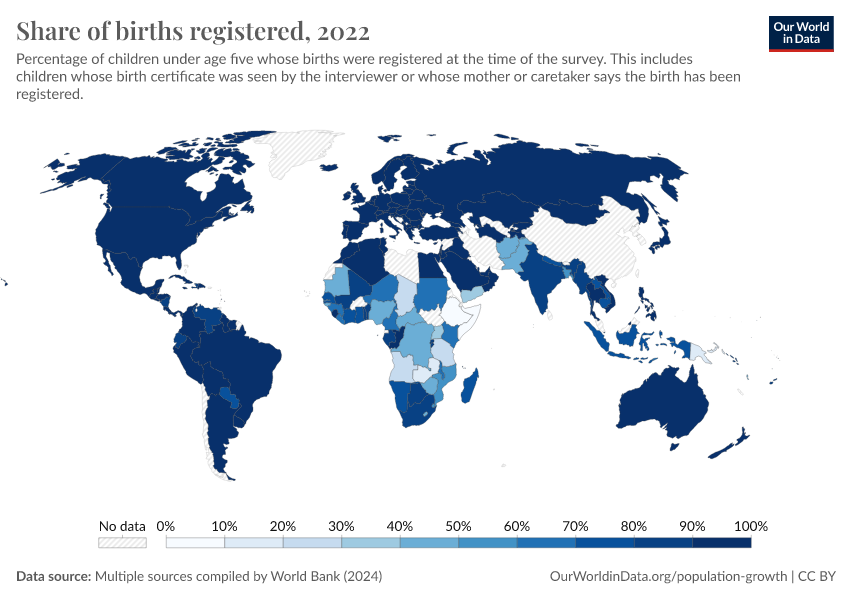
Target 16.10Ensure public access to information and protect fundamental freedoms
SDG Indicator 16.10.1Journalist and media killings
Definition of the SDG indicator: Indicator 16.10.1 is the “number of verified cases of killing, kidnapping, enforced disappearance, arbitrary detention and torture of journalists, associated media personnel, trade unionists and human rights advocates in the previous 12 months” in the UN SDG framework.
Data is available for the number of killings of human rights defenders, journalists, and trade unionists by gender.
Target: “Ensure public access to information and protect fundamental freedoms, in accordance with national legislation and international agreements” across all countries by 2030.
More research: Further data and research can be found at the Our World in Data topic page on Human Rights.
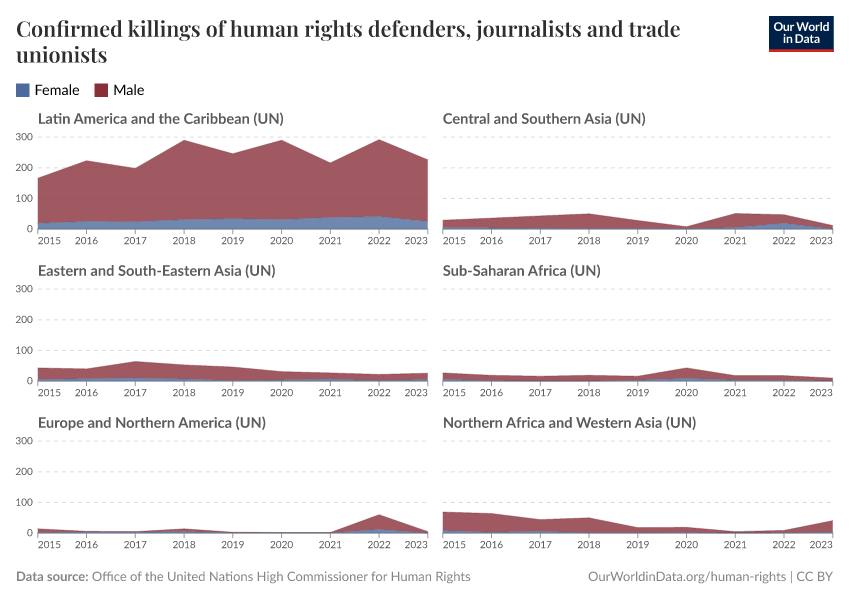
SDG Indicator 16.10.2Public access to information
Definition of the SDG indicator: Indicator 16.10.2 is the “number of countries that adopt and implement constitutional, statutory and/or policy guarantees for public access to information” in the UN SDG framework.
Data on this indicator is shown in the interactive visualization.
Target: “Ensure public access to information and protect fundamental freedoms, in accordance with national legislation and international agreements” across all countries by 2030.

Target 16.aStrengthen national institutions to prevent violence and combat crime and terrorism
SDG Indicator 16.a.1National human rights institutions
Definition of the SDG indicator: Indicator 16.a.1 is the “existence of independent national human rights institutions in compliance with the Paris Principles” in the UN SDG framework.
This indicator reflects compliance of existing national human rights institutions with the Principles relating to the Status of National Institutions (The Paris Principles) based on the rules of procedure of the Global Alliance of National Human Rights Institutions (GANHRI).
Data for this indicator is shown in the series of interactive visualizations.
Target: “Strengthen relevant national institutions, including through international cooperation, for building capacity at all levels, in particular in developing countries, to prevent violence and combat terrorism and crime” across all countries by 2030.
More research: Further data and research can be found at the Our World in Data topic page on Human Rights.

Target 16.bPromote and enforce non-discriminatory laws and policies
SDG Indicator 16.b.1Public discrimination
Definition of the SDG indicator: Indicator 16.b.1 is the “proportion of population reporting having personally felt discriminated against or harassed in the previous 12 months on the basis of a ground of discrimination prohibited under international human rights law” in the UN SDG framework.
Data on this indicator is shown in the interactive visualization.
Target: “Promote and enforce non-discriminatory laws and policies for sustainable development” across all countries by 2030.
More research: Further data and research can be found at the Our World in Data topic page on Human Rights.

Cite this work
Our articles and data visualizations rely on work from many different people and organizations. When citing this article, please also cite the underlying data sources. This article can be cited as:
Our World in Data team (2023) - “Promote just, peaceful and inclusive societies” Published online at OurWorldinData.org. Retrieved from: 'https://archive.ourworldindata.org/20260105-133053/sdgs/peace-justice-institutions.html' [Online Resource] (archived on January 5, 2026).BibTeX citation
@article{owid-sdgs-peace-justice-institutions,
author = {Our World in Data team},
title = {Promote just, peaceful and inclusive societies},
journal = {Our World in Data},
year = {2023},
note = {https://archive.ourworldindata.org/20260105-133053/sdgs/peace-justice-institutions.html}
}Reuse this work freely
All visualizations, data, and code produced by Our World in Data are completely open access under the Creative Commons BY license. You have the permission to use, distribute, and reproduce these in any medium, provided the source and authors are credited.
The data produced by third parties and made available by Our World in Data is subject to the license terms from the original third-party authors. We will always indicate the original source of the data in our documentation, so you should always check the license of any such third-party data before use and redistribution.
All of our charts can be embedded in any site.